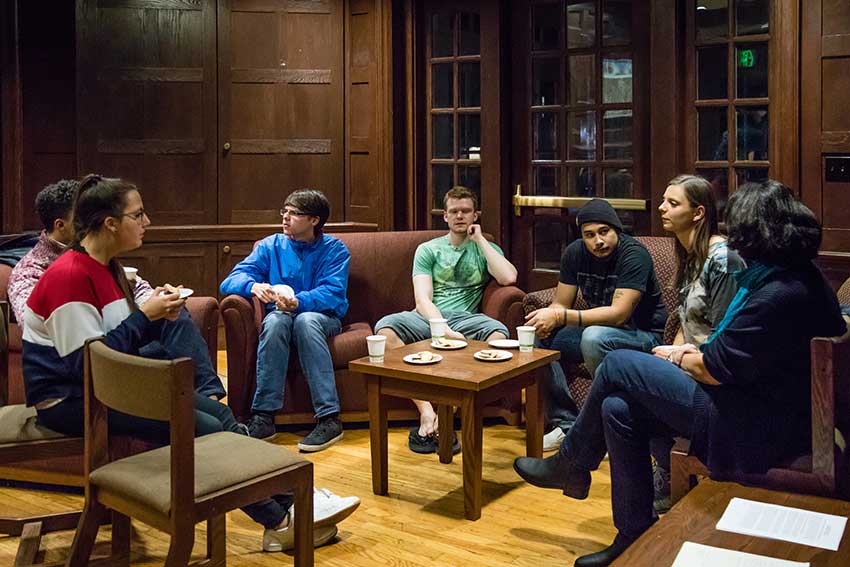At Amherst, community is expressed through numerous student clubs and organizations, resource centers and athletics. And for many students, it’s found in the buildings where they sleep at night.
While each residence hall has its own flavor, there are about a dozen places on campus where students live together around a certain theme, such as an academic interest, a cultural identity or a language.
For instance, on many a Tuesday night in Porter House, students and faculty come together for a little coffee and conversation, in German. The nine students in German House (the second floor, actually) organize a number of activities throughout the year, including an Oktoberfest party, lectures and films, but they take particular pride in the weekly Kaffeeklatsch, which is notable for attracting the department’s faculty.
“That’s a long-standing tradition,” says Anna Schrade, lecturer in German, who serves as advisor to German House. “It’s an occasion to meet students in an informal environment, and just stay connected and up to date about what’s going on with them.”
Being immersed in a language in a setting outside of the classroom exposes students to situations and vocabulary that might not pop up in an academic course, says Andreas Gilpin-Falk ’21, president of German House.

The Kaffeeklatsch attracts students who don’t even live in Porter, but who want to learn or practice their German.
“I just wanted to get my feet wet and get reacclimated to the sights and sounds of it,” says Anthony Ornelaz ’20, who came to Amherst after serving three years in the U.S. Air Force at Ramstein Air Base. He picked up some basic German commands there—he was in the military police—but he’s not quite fluent enough to hold up his end of a discussion, he says.
Not-yet-fluent speakers are welcome to the event, says Schrade:
“It’s for them. You want them to have this opportunity in a friendly environment, where it doesn't matter if they make mistakes.”
Other language theme communities at Amherst include Russian (also in Porter), Chinese and Japanese (Seligman), Spanish (Newport) and French (King).
Humphries House is a traditional co-op, where members work together to maintain the house, prepare meals, and organize house events together. Marsh Arts House is a space for student artists to produce and display their work.

Some theme houses are devoted to particular cultural and personal identities.
“I am Latinx myself, and I haven’t really engaged with the Latin community as much in my first two years, so I wanted to do that my third year as I prepare to go abroad, to Colombia,” says Daniel Delgado ’20, a resident of La Casa, a theme community devoted to celebrating and exploring Latinx cultures. One of the newest theme communities, La Casa is also located in Newport House.
Other culturally oriented theme communities include the Charles Drew Memorial Cultural House, devoted to celebrating black culture, and, on the second floor of Morrow, the Asian Culture House.
Membership can include people who don’t necessarily belong to these ethnic groups.
“I enjoy it, because a lot of the students who don’t identify as Latinx, who are still interested in living in this house, are essentially allies,” says Allyah Pimentel Landestoy ’21. “They're important to have in the conversations that we do have here because we need everybody to be a part of that.”
Newest to the collection of theme houses is the Sylvia Rivera Community, the home of 28 students on the fourth floor of Moore. Named for a gay liberation and transgender activist and veteran of the 1969 Stonewall riots, the living space is dedicated to creating a supportive community for LGBTQ students, says Esteban Uceda Arias-Stella ’19, its co-president.
“What it means to me is that I get to go home to people who somewhat grasp what my experience is like,” he says. “Part of building community is recognizing which experiences you might have in common. So intentional spaces make that a lot easier.”
